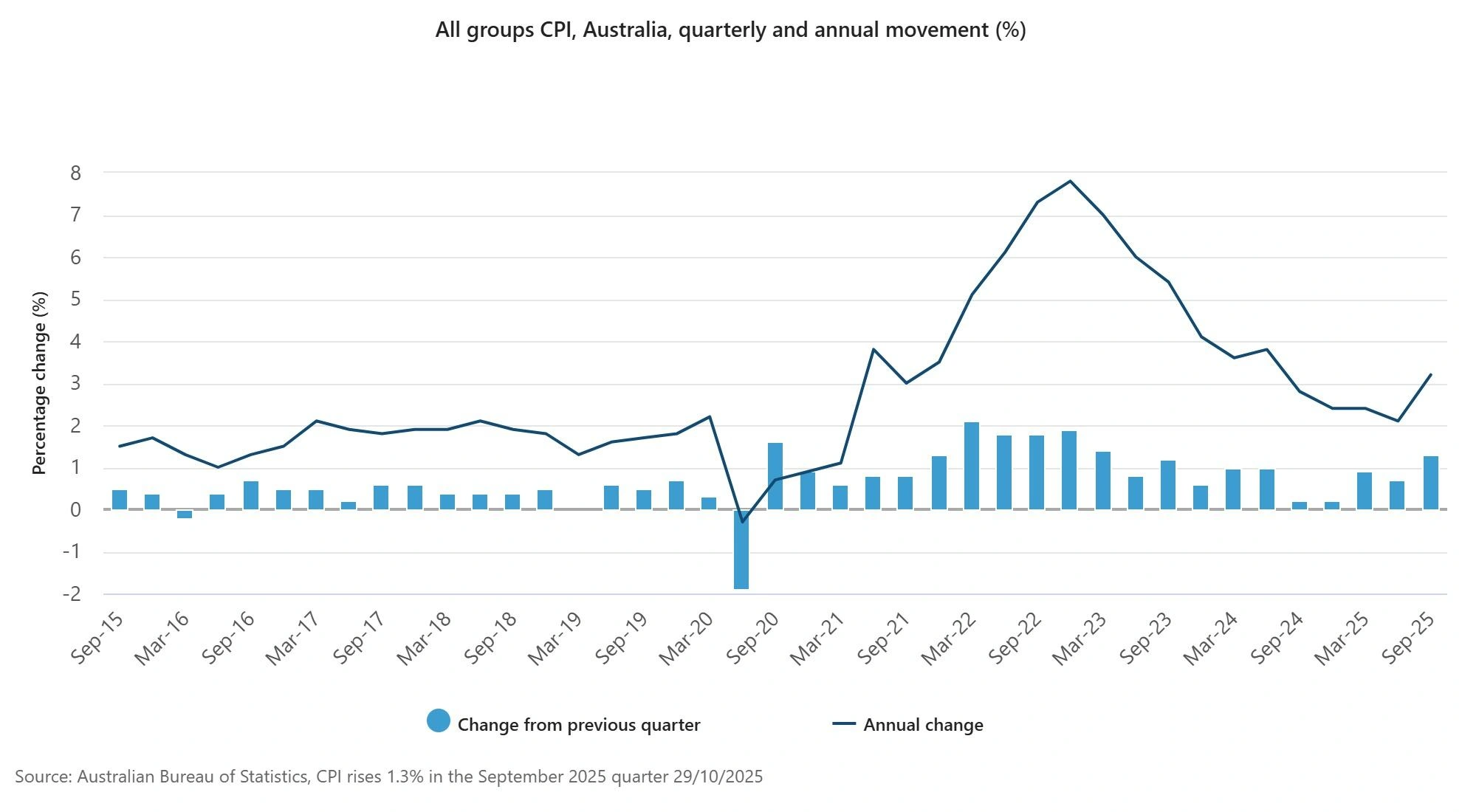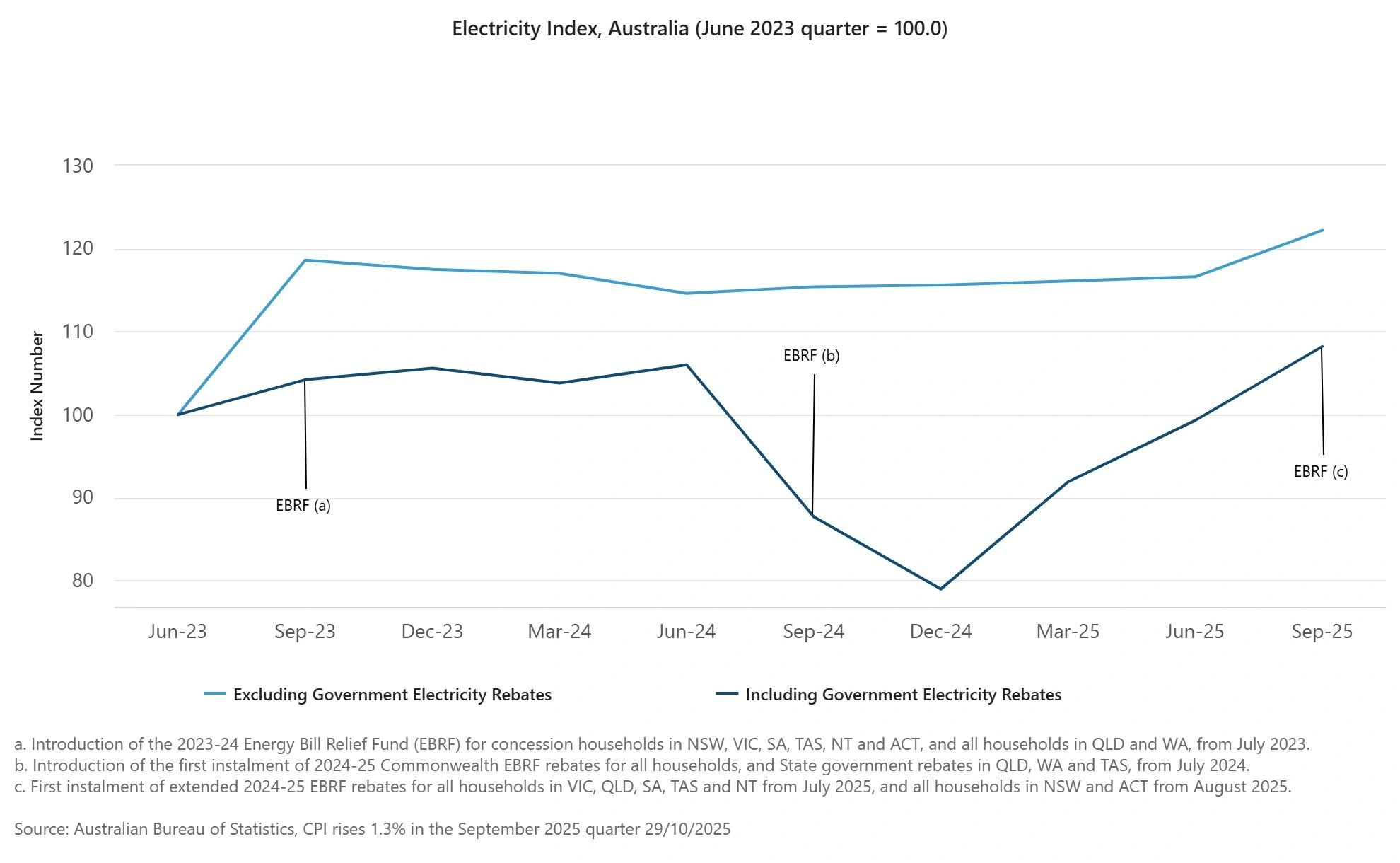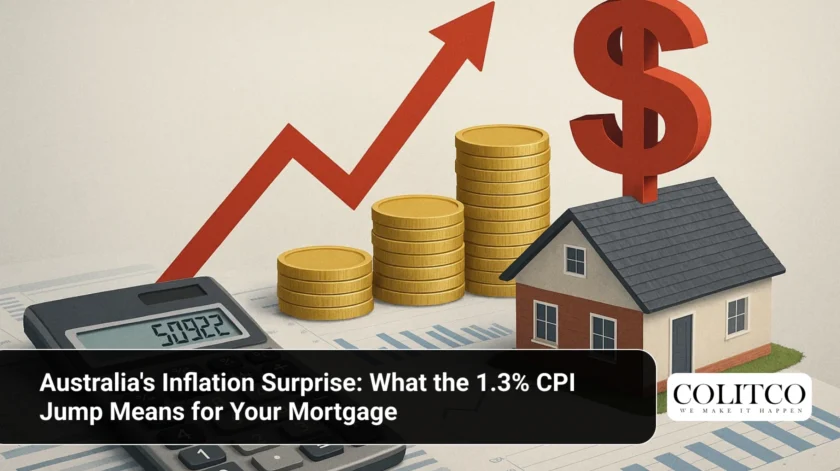Australia woke up to unwelcome news this morning. Consumer prices jumped 1.3% in the September quarter, the steepest quarterly rise in over two years.
The figure exceeded market expectations of 1.1%. Annual inflation surged to 3.2%, up sharply from 2.1% in June. This marks the highest annual rate since mid-2024.
The culprit? Soaring electricity bills and rebounding services costs. 
Graph showing Australian CPI quarterly and annual changes from 2024-2025
Electricity Bills Drive Price Surge
Electricity costs rose 9% in the September quarter. This was the single largest contributor to the overall inflation reading.
The Australian Bureau of Statistics (ABS) explained the spike stems from annual price reviews. These took effect across all capital cities from July.
Timing issues with the Commonwealth Energy Bill Relief Fund also played a role. NSW and ACT households missed payments in July, pushing their out-of-pocket costs higher.
“The CPI rose 1.3% in the September 2025 quarter, which is the highest quarterly rise since March 2023,” said Michelle Marquardt, ABS head of prices statistics.
Over the past year, electricity prices climbed 23.6% annually. This sharp increase reflects the wind-down of state government rebates in Queensland, Western Australia and Tasmania.

Electricity Index, Australia
Housing, Recreation and Transport Add Pressure
Housing costs rose 2.5% for the quarter. Beyond electricity, gas and other household fuels surged 6.7% following annual price reviews. Water and sewerage charges increased 2.7%.
Recreation and culture jumped 1.9%. School holidays in July and late September drove up domestic accommodation and airfare prices. International travel to Europe, peak season, pushed costs higher.
Transport rose 1.2%, with automotive fuel prices climbing 2% during the quarter.
Food and non-alcoholic beverages increased 3.1% annually. Meals out and takeaway foods rose 3.3%. Coffee, tea and cocoa spiked 14.6%, reflecting lower global coffee bean supply.
Core Inflation Beats Forecasts
The trimmed mean, a key measure of underlying inflation that the Reserve Bank monitors closely, rose 1% quarterly and 3% annually. This exceeded economist expectations of 0.8% quarterly and 2.7% annually. It’s the first acceleration in core inflation since late 2022.
Services inflation strengthened to 3.5% annually. Rents and medical costs led the increase. Goods inflation climbed to 3% annually, up from 1.1% in the previous quarter. This was driven mainly by electricity.
Rate Cut Hopes Take a Hit
Markets had priced in a high probability of an interest rate cut at the Reserve Bank’s November meeting. That optimism has now cooled. The RBA has cut rates three times this year, bringing the cash rate to 3.6%. Further cuts were expected as inflation had been moderating.
But RBA Governor Michele Bullock warned on Monday that a “material miss” on inflation would complicate the decision. She noted the bank must balance supporting employment against responding to higher-than-expected inflation.
The latest data suggests the RBA will hold rates steady next week. Markets now see only a slim chance of a November cut, with attention shifting to early 2026.
CommBank economists still expect one more cut in early 2026, bringing the cash rate to 3.35%. But timing depends on how quickly inflation moderates.
What This Means for Households
The inflation spike adds pressure on household budgets already stretched by higher living costs.
Electricity bills will remain elevated through the December quarter. The Commonwealth rebate extension runs until December 2025, but coverage varies by state.
Mortgage holders hoping for rate relief will need to wait longer. The RBA’s cautious stance means borrowing costs stay higher for longer.
Renters face continued pressure. Annual rent growth remained strong at 6.9%, though slightly down from previous peaks.
Economists note Australia’s economic recovery remains fragile. GDP growth is modest, and unemployment has drifted to 4.3%.
Global Context: Energy Drives Inflation Worldwide
Australia’s experience mirrors global trends. Energy price shocks continue rippling through economies worldwide.
Central banks from the US Federal Reserve to the European Central Bank have paused or slowed rate cuts. Inflation remains above target in many developed economies.
The RBA faces a particularly delicate balance. Australia avoided recession, unlike New Zealand. But growth remains weak and productivity low.
ABS Shifts to Monthly CPI Reporting
Today marks the final release of the quarterly CPI as Australia’s primary inflation measure. The monthly CPI indicator also ceased publication.
From November, the ABS will publish a complete monthly CPI. This aligns Australia with all other G20 countries.
The change provides more timely data. It allows the RBA and markets to respond faster to emerging price trends.
Expert Views: Caution Prevails
Economists are divided on the RBA’s next move.
Some argue the bank should cut rates to support the economy. Growth remains below trend, and labour market slack is increasing.
Others warn that cutting too soon risks reigniting inflation. Core services inflation remains elevated, suggesting price pressures haven’t fully dissipated.
The consensus tilts toward a hold in November. Any further cuts will likely come after clearer signs that inflation is sustainably returning to the 2-3% target midpoint.
The Road Ahead
The September quarter data complicates the RBA’s task. Inflation is above target, but growth is weak.
Households face a difficult period. Energy costs remain high, food prices are rising, and mortgage relief is delayed.
The next few months will be crucial. October’s monthly CPI data, due in late November, will provide fresh insight.
If inflation moderates quickly, rate cuts could resume in early 2026. If it remains sticky, the RBA may need to hold rates higher for longer.
For now, Australians will need patience. The path to lower interest rates just got bumpier.
Also Read: Woolworths Faces Reality Check as First Quarter Sales Fall Short Despite Growth
Frequently Asked Questions
Q: Why did inflation jump to 1.3% in the September quarter?
A: Electricity costs rose 9% quarterly, contributing the most to inflation. Annual price reviews took effect in July, and timing gaps in energy rebate payments in NSW and ACT increased household bills. Housing, recreation and transport costs also climbed, driven by school holiday travel and rising fuel prices.
Q: Will the RBA cut interest rates in November 2025?
A: A November rate cut now appears unlikely. The unexpectedly high inflation reading, particularly the 3% annual trimmed mean inflation, has dampened expectations. The RBA will likely hold the cash rate at 3.6% and wait for clearer evidence that inflation is returning to the 2-3% target range.
Q: How long will electricity prices remain high?
A: Electricity bills will likely stay elevated through December 2025. The Commonwealth Energy Bill Relief Fund rebate extension runs until December, but annual price reviews are now flowing through. Without government rebates being renewed beyond 2025, households should expect higher energy costs into 2026.
Q: What does rising inflation mean for my mortgage?
A: Higher inflation delays interest rate cuts. Mortgage holders hoping for relief will need to wait longer, likely until early 2026. The RBA’s cautious approach means borrowing costs stay elevated. Each month of delay adds to household financial pressure, particularly for those on variable rate loans.
Q: When will Australia’s inflation return to the RBA’s target?
A: The RBA forecasts inflation will reach around the 2-3% target midpoint by mid-2026. However, this depends on electricity prices stabilising, services inflation moderating, and wages growth remaining contained. The transition to monthly CPI reporting in November will provide better real-time insights into whether inflation is tracking as expected.











